Mary Beth Appel, Will Owens* and Johanna Berrigan inside the Catholic Worker clinic at East Hagert in Philadelphia before shutting down for the day (Sarah Salvadore) *Owens' first name has been corrected. We regret the error.

Martha Hennessy in the library adjacent to the Maryhouse chapel, part of the Catholic Worker houses in New York City (Mercedes Gallese)
Martha Hennessy sits in a library adjacent to the Maryhouse chapel in New York, where the wake for her grandmother, Dorothy Day, was held in 1980.
Photos of Day and other Catholic social justice activist heroes, such as St. Óscar Romero, line the walls. A few blocks away at Joseph House, also a Catholic Worker facility, a soup lunch is being prepared for guests — much like it has been since Day, with her friend Peter Maurin, began the Catholic Worker movement in 1933.
Like her famous grandmother, Hennessy describes fame as a danger. A cult of celebrity will do the movement no good, she says. But the movement is awaiting a renewed burst of interest, as a PBS documentary on Day is planned to air March 6.
Hennessy is cooperative with the documentary project, which she describes as an important historical statement. On this January day, she has just returned here from Georgetown University in Washington, D.C., where she had participated in a panel on Day's legacy the night before.
Advertisement
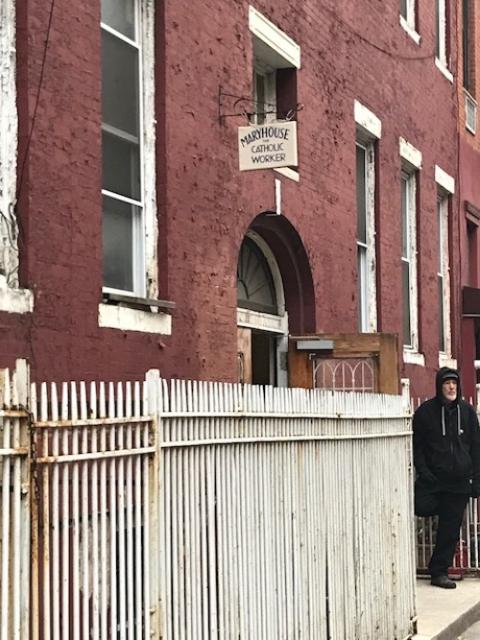
The Catholic Worker Maryhouse shelter and soup kitchen in New York City (Mercedes Gallese)
That legacy is being tested in Day's canonization cause led by the New York Archdiocese, an entity that clashed with Day's militant pacifism in the midst of the Cold War. Day once famously remarked that she didn't want to be considered a saint, because she didn't want to be dismissed that easily.
"The U.S. culture loves the celebrity culture," says her granddaughter, wary of the possible attention the documentary may generate. "We do that to keep us out of the hot seat. Who wants to walk to the cross? We all have to deal with that."
Walking to the cross is a concept Hennessy embraces. In the spirit of Catholic Worker activism, she faces a 20-year possible sentence for conviction of trespassing into a Georgia nuclear weapons facility as part of a 2018 protest.
Day was regularly arrested in protests, the most famous being a refusal to cooperate in a civil defense drill in 1955 in Times Square. She experienced relatively short jail stays.
There may be a little less patience with civil disobedience in this era as Hennessy could face much more time. Soft spoken, her rhetoric contains a sharp edge. She describes herself as a convicted felon, with more than a small sense of pride.
Like her grandmother, who through the pages of the Catholic Worker, the organization's newspaper that since the Great Depression still sells for a penny a copy, Hennessy offers a scathing critique of the wider culture.
"All of our structures are getting corrupted. That was Dorothy's point," she says.
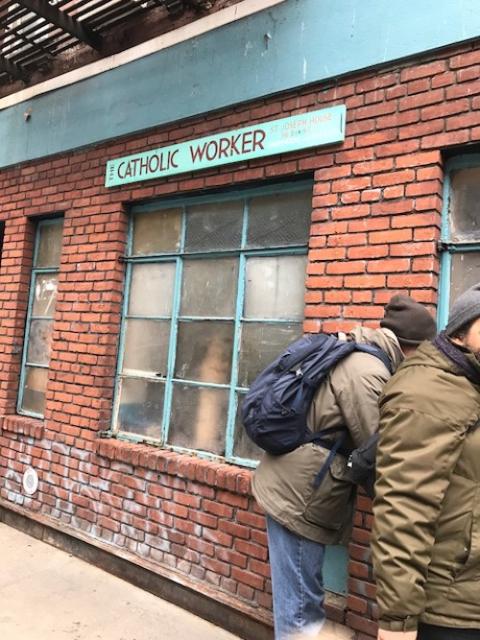
People outside of the Joseph House, part of the Catholic Worker facilities in New York City (Mercedes Gallese)
Keeping 'Catholic' in Catholic Worker
Much like it did during the Great Depression, the Catholic Worker welcomes the poor with a shelter and soup kitchens in New York at Maryhouse, which largely assists women, and a few blocks away at Joseph House, which focuses on men.
The concept is called hospitality. No one is turned away, a long-term point of pride for Catholic Worker houses, dozens scattered around the country in a loose-knit network. Modern organization has never been a Catholic Worker trait; the group has long held to tenets of Christian anarchism. Catholic Worker volunteers pride themselves on serving those who tumble through the cracks, those with no identity papers or birth certificates, sometimes because of foreign birth or the difficulties maintaining paperwork faced by people who are mentally ill or living with addictions.
In the 1930s and beyond, Day would write about the struggles of the Lower East Side, how poverty and despair lined the streets. These days, the rich have invaded the neighborhood (Hennessy avoids the polite term of gentrification). The Catholic Worker's ragged buildings could now fetch millions. There have been serious discussions about whether the community should be moved to where the poor have been displaced. Around the block, the former Church of the Nativity, where Day was a regular communicant, is being demolished to make way for hyper-luxury housing.
In today's Manhattan, the Catholic Worker facilities are surrounded by towers that rent one-bedroom apartments for $4,000 a month, and one is as likely to encounter celebrity comedians on morning strolls as the anarchistic street scene that Day described in her writings.
Hennessy, before talking with NCR, devoutly lights the chapel altar candles and does the sign of the cross. But she acknowledges keeping the Catholic in Catholic Worker is no easy task. It's harder, she says, to make the connection to the church and the Gospel at a time of widespread defections from the church, and a sense that American bishops have sold themselves to the Republican Party and monied interests (they need to listen to Pope Francis, she says). Few are willing to make the connection between Catholicism and social activism, she says, expressing concern that Day's founding charism will survive.
"The harvest is great; the laborers are few. There is so much work that needs to be done," she says.
But the work continues beneath the prosperous veneer. The Lower East Side doesn't lack for desperation, Hennessy emphasizes. Homelessness is aggravated by addiction and stratospheric rents. Much of Manhattan's gleaming new apartments, she notes, sit empty, sold to foreign plutocrats who only occasionally come to the city to indulge its attractions. Meanwhile, people sleep on the streets, a concern that hasn't abated, even while neighborhoods such as the Lower East Side are transformed.
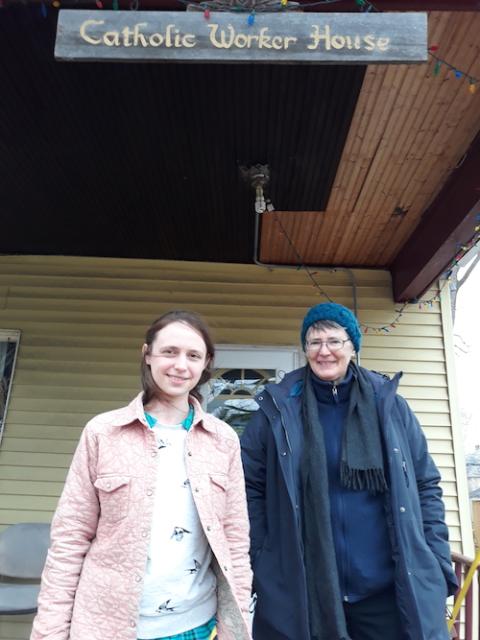
Margie Pfeil, right, co-founder of the South Bend, Indiana, Catholic Worker community, with Emma, one of the current resident of the women's house (Don Clemmer)
Anarchy at scale
In South Bend, Indiana, the Catholic Worker facility faces a different set of challenges.
The 500-block of S. St. Joseph Street, which Catholic Worker of Michiana calls home, has a bit of "a village feel," according to resident and co-founder Margaret "Margie" Pfeil. With the St. Peter Claver House for men and a second house for women located across the street from one another (and the separately affiliated Dismas House for the formerly incarcerated a couple doors down), the Catholic Worker's presence among the sprawling old wooden houses on the south side of downtown is one of sometimes hidden but ever unfolding renewal in the midst of need and neglect.
"We've been around a while now, and we have good relationships with the agencies in town," says Pfeil, one of three founders of the South Bend house in 2003. "We're known in town, and people have accepted that we do things a little bit differently."
She refers specifically to the practice of personalism, something embraced by Day and Maurin, of directly encountering the people they serve and taking responsibility for their well-being. When the South Bend houses opened, people who'd had their water turned off showed up with empty milk jugs to fill and needing showers.
Today, the 10 or so residents of each house take people to appointments or volunteer shifts at the Our Lady of the Road drop-in center for the homeless, located a few blocks from the houses.
"I pray with Dorothy every day, and I feel like she's with us. And her writing has been very important to sustain us," says Pfeil, whose full-time job is professor of theology and social ethics at the University of Notre Dame. "The trick is having enough structure … to sustain it over time without squashing the impulses of the Spirit."
She sees Day's vision of "Christian anarchy" — lots of little communities feeling called within their particular local contexts — as operating at a very specific scale as not to "lose the possibility of that kind of relationality."
The scale of their work includes a volunteer staff of about six people working to coordinate the great amount of support from local churches, schools and the wider community.
Our Lady of the Road drop-in center, which opened in late 2006, is located near the main bus terminal, the jail and the Social Security office, a good location for people without a car. A former auto parts store, the center serves breakfast for about 140 people and is open for showers and laundry every Friday, Saturday and Sunday. More recently, due to a renovation of the local library, the city requested that Our Lady of the Road also serve as a warming center, which it has done every afternoon this year and will do so through April.

A table in the cooperative grocery story at the Our Lady of the Road drop-in center in South Bend, Indiana (Don Clemmer)
It's just another way that the sprawling facility has stretched in a new direction over the 14 years of its operation. In addition to laundry, showers, meals and warmth, the center also offers a cooperative grocery store run by a local family; office space for the Catholic Peace Fellowship; a wood shop that the Catholic Worker community uses to make caskets for green burials; and even a space that is being developed for art therapy.
Sheila McCarthy, who was part of the Catholic Worker community for seven years and still volunteers at the drop-in center, sees this organic spread as inherent to their work.
"The Worker is a unique place because it always allows for new beginnings and new possibilities," McCarthy says, adding that the movement lets "people explore the things that make them the most human," while at the same time frees them from materialism, careerism and the pressure to make a name for themselves.
On the second floor of Our Lady of the Road, a simple chapel's windows look out onto not only solar panels installed on the roof, but also the jail in the distance. Praying there — Mass is every Wednesday evening — is a different way of being in solidarity with the incarcerated, says Pfeil.
Of the importance of Mass, "[Day] said it's not to support the work of the day; it is the work of the day, and everything else is oriented around that," Pfeil says. "That's certainly what drew me to the Worker."
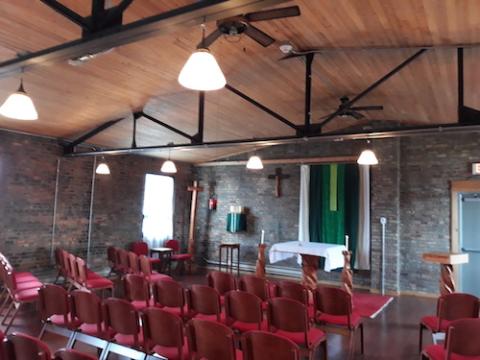
The chapel on the second floor of the Our Lady of the Road center (Don Clemmer)
Call of the young
Pfeil notes that the Catholic Worker also consistently draws young people to the table.
"Most of the folks are in their 20s and 30s. I'm the elder person here," she says. Pfeil seeks to cultivate younger leadership among the community. She's seen it happen in other Catholic Worker communities that someone in leadership for a long time steps away, only to have no one ready to step in.
Pfeil says the presence of colleges in and around South Bend — not only the University of Notre Dame and other Catholic schools, but also evangelical Bethel University — means the Catholic Worker has become a place of discernment for many young people, often for a year or two after graduation.
"The Worker is a place where they can sort out those competing messages, values, desires and then discern for themselves who are they are, and who are they becoming and where are they headed in their lives," Pfeil says.
As local campuses also have plenty of people who are pretty well off, she says, "The Worker and Our Lady of the Road are places of encounter for people who would otherwise probably never meet." The houses host dinner every evening for 20 to 25 people, and Pfeil notes that it's the only context in which many of these people would ever break bread together.
"I see it over and over, but God works in that to meet the needs of each person in very specific ways." The relationship that develops, she adds, "becomes a place of healing."
Pfeil sees a growing movement. Especially with the climate crisis, she notes that she has seen people, alienated by industrialization and literate in the Catholic Worker movement, who have started Catholic Worker farms and otherwise changed their lifestyles to be closer to the land. This ecological thrust is echoed in the South Bend community's own efforts toward future sustainability through coffin making and green burial services.
And accompaniment, care for creation, mercy and encounter with those on the peripheries are also all hallmarks of the pontificate of Pope Francis. It raises the question of whether, nearly a century into its work, the Catholic Worker is poised to flower into a renaissance in the life of the church. To this, Pfeil notes that Day herself envisioned a church in which Catholic Worker houses were unnecessary because the parish lived fully into the works of mercy.
"Peter Maurin said, if you lead, the bishops will follow," McCarthy says. "And I think there's really a sense of Francis following the best instincts of the church … highlighting what's already happening and writing about it so beautifully."
Dealing with a drug epidemic
In Philadelphia, the Catholic Worker faces identity issues similar to the pioneering houses in New York as their work takes place in a neighborhood that the poor are increasingly being expelled from.
On a Wednesday morning, the block in the Kensington section in Philadelphia is teeming with homeless men and women lined up outside a converted row home. This address on Hagerty Street is where the Catholic Worker runs its free clinic four times a week. The clinic is next door to St. Francis Inn, a Franciscan soup kitchen, and across the street is Marie's Closet, a second-hand clothing center that offers free clothes and shoes to the homeless.
There's a flurry of activity at this center — homeless men walk in to take a shower and leave with a clean socks, underwear, a toothbrush and some essentials. Others come in for their weekly medical check-up.
Run by Johanna Berrigan and Mary Beth Appel, this house provides medical assistance to a population struggling to meet their healthcare needs. Berrigan and Appel also live in and run the House of Grace — the Catholic Worker hospitality house, alongside their own house, just a few blocks away. The duo moved from Los Angeles, where they volunteered at the Catholic Worker House, to Philadelphia in 1991.
"We were here, right at the height of the AIDS epidemic. A lot of our hospitalities was with people with HIV or AIDS, who were sick and were trying to get into hospices, but were homeless in between," said Appel, a Philly native.
Over the years, the number of people visiting the clinic has increased. But the nature of the services offered has seen a change. Philadelphia is now home to the country's worst big-city opioid crisis.
"Until the opioid crisis, I never had to do CPR or reverse an overdose," says Berrigan, a physician's assistant. "And now, it's a very common occurrence. I've lost count of how often we have to be on high alert."
Around the time the opioid crisis hit the city, so did gentrification. The homeless, who would find refuge in vacant homes and lots, are now left without any shelter, making them even more visible. Homelessness, coupled with the opioid crisis has resulted in many losing their lives.
"There are folks with severe mental health situations that's keeping them from finding shelter. They don't feel safe going to shelters and now they are on the streets," says Appel.
For the past 28 years, the Catholic Worker in Philadelphia has continued the deep-rooted Catholic tradition started by Day, revolving around the Eucharist and community. On the face of it, it seems like a lot has changed, but at the same time, much has remained constant. "Addiction and homelessness is a generational problem," says Appel. The gentrification has made their new neighbors uncomfortable with those coming in to seek help at the clinic. With downtown just three miles away, the homeless are now being pushed north — away from accessible services.
Winter view of the community Garden at House of Grace, the Catholic Worker Hospitality house in East Lehigh Avenue in Philadelphia, showing a mural drawn by one of the former residents of the house (Sarah Salvadore)
In the beginning, the hospitality house at Lehigh Avenue would take in high-risk individuals — those who were volatile and mentally ill — as Appel and Berrigan were comfortable dealing with any situation.
But lately, the house is seeing more undocumented immigrants and refugees seeking shelter.
"We've had a number of sick immigrants — two different undocumented guys with cancer, folks straight out of refugee camps from Burma, Sudan and Iraq. Tons of asylum seekers — folks that just sort of slipped in under the radar," says Appel. This change has brought in a different atmosphere to the house — one that is calm and with less potential of volatility.
Continuing to engage
Appel and Berrigan are adapting to these changes with inspiration from Day and by keeping alive Catholic social teaching. On the first Monday of every month, a roundtable discussion on the liturgy used to be held. Around 25 to 30 people used to attend the service, but those numbers have dwindled. As old timers die and young members of the community move on, the duo found it difficult to sustain the group. Last year for the first time, the Monday service was stopped.
"We are in conversation right now for, 'How are we going to create this spiritually nurturing community?' A huge part of what kept us active and engaged was meeting people and it's not happening now," says Berrigan. She also admits that the clerical sex abuse crisis contributed to a lot of their members dropping out.
"We continue with our centering prayer circle meet once a month. But that's different from liturgy that's Catholic focused. We are seeing less interest," says Appel.
As their liturgical initiatives are sidelined, the current political environment is proving to be a blessing. They are attracting young volunteers from Bryn Mawr College, Temple University, Pennsylvania State University and Villanova University to volunteer with the organization.
"Amongst my peers, where people felt unsure on how to react to the current xenophobic political climate, the Catholic Worker has provided a way for us to engage actively," says Will Owens, a guest of the hospitality house and caretaker of the community garden. "The Catholic Worker has been addressing that for a really long time. And so for me, it's easy to plug into that."*
Appel and Berrigan are concerned about the future. They've been contemplating ways to motivate young people to become a more permanent part of the mission. With a solid core of extended volunteers who come in on a weekly basis, the Catholic Worker is looking for more permanent members to join the fold, even though Appel and Berrigan have no plans of retiring anytime soon.
"We have a lot of [people] involved, but no one that lives in the [hospitality] house and makes this commitment over the long term or even for a year or two. It's really hard to meet people that want to do that for us," says Berrigan.
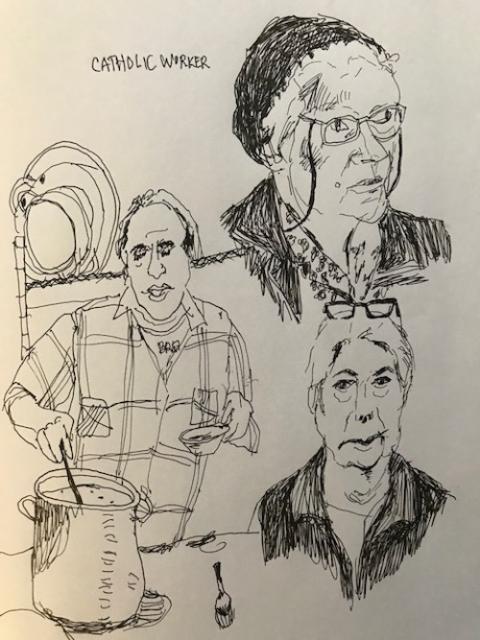
Sketch of Dorothy Day, top, Martha Hennessy her granddaughter, lower right, and a Catholic Worker cook in New York by Mercedes Gallese
Back in New York, Hennessy, Day's granddaughter, notes that the public television documentary is selling well on Amazon, creating an uptick in interest in the Catholic Worker and its mission. The film earned the top spot on Amazon's film documentary listing. Hennessy is not so sure that's a good sign. It's part of the wider ongoing critique of the larger culture the Catholic Worker has long been known for amidst its work with the poor.
Amazon's bigness, its connection to questionable labor practices and its environmental policies, raises flags. Catholic Worker has a long suspicion of bigness, and there is nothing bigger than Amazon. "We have corporate control. It contributes to every problem we have," she says.
Channeling her grandmother, Hennessy continues her critique. Even as the capitalist system sells a documentary extolling the virtues of the Catholic Worker movement, the anarchistic Christian critique of the system continues.
*This story has been updated to describe Will Owens as a guest of the hospitality house.
[Peter Feuerherd is NCR news editor. Don Clemmer is a journalist, communications professional and former staffer of the U.S. Conference of Catholic Bishops. Sarah Salvadore is NCR's Bertelsen intern, based in New Jersey.]









